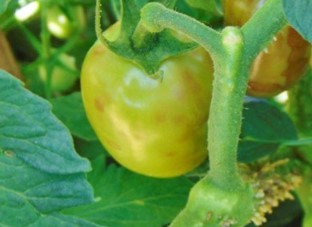By Beth K. Gugino
Downy mildew lesions on the upper surface of a cantaloupe leaf.
No new reports of late blight since the confirmations on tomato in York County and on potato and tomato in southern Lancaster County a couple of weeks ago.
If you suspect late blight, please contact your local Penn State Extension office or let Beth Gugino know via email at bkgugino@psu.edu or by phone at 814-865-7328. For the latest reports check
USBlight.org.
Cucurbit Downy Mildew: Recent Weather Favored Disease Spread
The recent unsettled weather pattern that generated severe storms across some parts of the state put much of the central and eastern Pennsylvania at high risk for downy mildew spread and disease development. This was primarily from inoculum sources in the mid-Atlantic region. However, on Monday (July 16) downy mildew was confirmed in a cucumber field a couple of counties south of Richmond, VA. This report bridges the gap between the reports further south along the east coast and those on the Delmarva Peninsula. Depending on environmental conditions symptoms from these most recent events will become visible and produce spores in as few as 4 to 12 days. So continued scouting over the next week is critical. Downy mildew specific fungicides are recommended for both cucumber and cantaloupe. The pathotypes that infect these crops are very similar, and in our region, we typically confirm downy mildew first on cucumber and then shortly after on cantaloupe. Ideal downy mildew weather for spore production includes temperatures between 50 and 68°F and free moisture from heavy dew, rain or high relative humidity for 6 to 12 hours.
Statewide downy mildew has only been reported to-date on cucumber in Mifflin County There have been no reports of downy mildew on jack-o-lantern type pumpkin in the eastern US. Protectant fungicides that are being tank mixed for the management of powdery mildew will also help protect against downy mildew. At this time, the closest reports on butternut squash are in North and South Carolina.
See previous updates for specific management recommendations.
If you suspect cucurbit downy mildew on your farm, please contact your local Penn State Extension Office or let Beth Gugino know via email at bkgugino@psu.edu or by phone at 814-865-7328. Every confirmed report of downy mildew enables us to improve disease forecasting accuracy for the benefit of cucurbit growers not only in Pennsylvania but all along the east coast. Even reports made from previously reported counties. The latest information on reports of cucurbit downy mildew can be found at the
CDM ipmPIPE website.
Have you seen any viral diseases in tomato?
There have been several reports of viruses or virus-like symptoms in tomato and more specifically high tunnel tomato. Symptoms of viruses range from bronzing, mottling (light/dark green areas), and necrosis of the leaves to severe leaf distortion (e.g., shoestring) and stunting of the plant. Often it is difficult to identify viruses simply based on symptoms and submitting samples for further diagnostics is often recommended. The Penn State Plant Disease Clinic can routinely check for tomato spotted wilt virus (TSWV), impatiens necrotic spot virus (INSV), cucumber mosaic virus (CMV) and tomato/tobacco mosaic virus (ToMV/TMV). Typically once symptoms are observed there is not much that can be done regarding management aside from potentially rogueing the symptomatic plants to prevent further spread. However, identifying the causal virus can help inform management strategies next season. Keep in mind, that herbicide injury can also cause symptoms similar to those of viruses and that there are over 20 viruses that affect tomato so submitting a sample to a
diagnostic lab such as Agdia may be necessary.

Subtle mottling caused by tobacco/tomato mosaic virus (ToMV/TMV) on tomato.
Bronzing caused by tomato spotted wilt virus (TSWV) on tomato.
Many viruses are vectored by insects, so management needs to be focused on the insect rather than the virus. Thrips, more specifically the western flower thrips and tobacco thrips are the primary vectors of TSWV. This virus is characterized by bronzing on the leaf surface, possible stunting of the plants and chlorotic/yellowish rings on fruit if infected later in the season. Another example is CMV which is vectored by more than 75 different aphid species. The most distinct symptom is the “shoestring” strapping of the leaves. That being said, there are also viruses that are transmitted (or moved around) mechanically on people’s hands, clothing or tools. An example of a mechanically transmitted virus would be ToMV/TMV. Washing hands frequently with soap and water and consider disinfesting tools regularly with 20% nonfat dry milk solution to denature the virus particles.
Shoestring leaf distortion caused by cucumber mosaic virus (CMV) on tomato.
In general, many of these mentioned viruses have a wide host range that includes many weedy plant species which commonly serve as a reservoir of virus upon which the vectors can feed on. So weed management in addition to a three-year rotation to allow crop residue to thoroughly decompose is important. Host resistance is also an option for a number of viruses. See the
2018 Mid-Atlantic Commercial Vegetable Production Recommendations for a more complete list of recommended cultivars and their disease resistance.